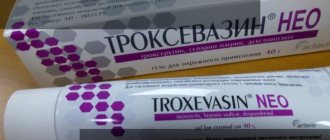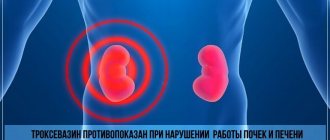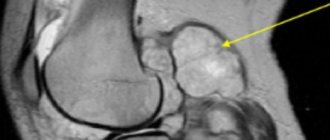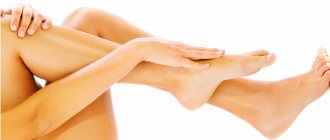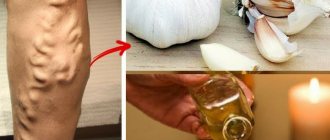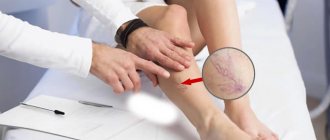What is Troxevasin
A medicine based on the angioprotective active substance troxerutin. Regulates the tone of capillary vessels and veins. It is used to eliminate pain, swelling and trophic disorders caused by their dysfunction.
Troxevasin is produced:
- in the form of an ointment for topical use: a viscous yellowish gel-like mass containing 2% troxerutin, packaged in 40 g tubes;
- in the form of capsules for oral administration: in a dosage of 300 mg of the active substance, gelatin, in blisters.
The product has a pronounced venoprotective effect. It helps reduce the permeability of vascular walls, improves blood outflow, prevents its stagnation in the lower extremities, prevents thrombus formation and the development of inflammatory processes. Troxevasin alleviates the underlying symptoms of varicose veins and slows down its progress.
Questions from patients about the treatment of varicose veins with ointments and gels
Marina from Moscow asks: what ointment can cure varicose veins?
Dear Marina! The modern pharmacology industry offers a good selection of ointment and gel forms of drugs. Many of them have a good local cooling, soothing, anesthetic effect. But even the best ointment cannot cure varicose veins. The latter is a surgical disease and requires appropriate treatment.
Angelina from Moscow is interested in: what is the effective treatment for varicose veins with folk remedies, what ointments do you recommend?
Dear Angelina! Folk remedies include a balanced diet, proper exercise and rest. This will help to prevent varicose veins to some extent. There is not a single truly effective folk remedy, as well as ointment, for the treatment of varicose veins that have already appeared.
Lyudmila from Moscow asks: my mother has had varicose veins of the lower extremities for many years, she is regularly treated with ointment and good tablets. At the same time, the dark spot on the left leg increases. What tablets or ointments do you recommend for the treatment of varicose veins?
Dear Lyudmila! If your mother is diagnosed with varicose veins and clinically significant reflux is detected in the superficial venous system, then treatment with tablets and ointments will not help. It is necessary to contact a good phlebologist and follow his recommendations. Otherwise, the progression of venous insufficiency will lead not only to darkening of the skin, but also to the formation of a trophic ulcer.
Valentina from Moscow asks: I was diagnosed with varicose veins of the lower extremities, prescribed pills and a good ointment, judging by the reviews. I have been undergoing treatment for 2 months now, the skin on my legs has begun to peel off, is it possible to interrupt the treatment?
Dear Valentina! If you have been diagnosed with varicose veins of the lower extremities, then even a very good ointment and the best tablets, unfortunately, will not help. A completely different approach is needed here. The best option for you is to contact a good city phlebological center in Moscow, where, after a face-to-face consultation and professional ultrasound scanning, a specialist will answer your questions in more detail.
What is Troxevasin used for?
Medicinal ointment and capsules are prescribed:
- for chronic venous insufficiency;
- lack of nutrition of soft tissues caused by varicose veins;
- with postphlebitic syndrome;
- trophic ulcers;
- for symptoms of hemorrhoids;
- with retinopathy against the background of hypertension and diabetes.
The drug is used to prevent complications after surgical treatment of varicose veins, to prevent further vascular damage in the initial stages of pathology. Troxevasin is also indicated to improve well-being after mechanical injuries: bruises or sprains.
The active substance from the capsules is absorbed in the intestines. Its maximum concentration in the blood is observed 1.5–2 hours after administration. Metabolized by the liver and completely leaves the body within 0.5–1 day. Troxerutin from the ointment penetrates all layers of the epidermis, dermis and subcutaneous tissue within 3–5 hours.
Troxevasin in the prevention and treatment of chronic venous insufficiency in women
About the article
2215
0
Category: General articles
Authors: Serov V.N. 1, Baranov I.I. 1 Russian Society of Obstetricians and Gynecologists, Moscow, Russia
Chronic venous insufficiency (CVI) of the lower extremities is currently the most common pathology of the human vascular system. CVI of the lower extremities is characterized by disturbances of venous outflow at the macrohemodynamic level, which lead to disorganization of the regional microcirculation system. We owe the appearance of this pathology in the spectrum of diseases of the human body to the transition of our distant ancestors to movement in an upright position. Man is the only representative of the animal world on the planet who suffers from CVI.
The fact that the problem of CVI was well known to our predecessors is evidenced by the monuments of ancient civilizations and the works of great doctors of the past. In Egypt, doctors were actively involved in the treatment of trophic ulcers - traces of these effects were found in a mummy from a burial that dates back more than 3,500 years. We find images of people with bandaged feet in the drawings of African tribes and in the paintings of the temples of the first Christians. Such luminaries of medical science as Hippocrates and Avicenna devoted entire sections of their works to describing the diagnosis and treatment of venous diseases. This problem was not ignored by their famous followers - Ambroise Paré, Paracelsus, Theodor Billroth and others. Epidemiological studies show that chronic venous diseases are observed in more than a third of Russians, and more often in women than in men. Such a high frequency of occurrence allows us to safely call CVI a “disease of civilization.” Moreover, if previously the disease was attributed to the problems of people in the older age group (over 50 years), now the first signs of venous reflux are detected in 10–15% of schoolchildren aged 12–13 years. It is obvious that the development of CVI is a process extended over time, i.e. provided that the disease is identified and treated in the early stages, it is possible to actually reduce the number or at least prolong the appearance of severe forms of the disease. Traditionally, it was believed that the pathogenesis of CVI is based on valvular insufficiency of various parts of the venous bed of the lower extremities, leading to the appearance of pathological, retrograde blood flow, which is the main factor in damage to the microvasculature. This theory is based on the results of a macroscopic examination of the venous system of the lower extremities, first using radiopaque venography, and then using non-invasive ultrasound methods. However, a large number of patients were identified with complaints characteristic of CVI in the absence of valve pathology. At the same time, the use of plethysmography recorded a violation of the tone of the venous wall of varying degrees of severity. Thanks to this, the hypothesis was put forward that CVI is not a valve disease, but a pathology of the vein wall. It has now been proven that in the presence of various risk factors (genetic defects of collagen, changes in hormonal levels, prolonged static loads, overheating of the body, insufficient physical activity, etc.) and under the influence of gravity, the pressure in the venous knee of the capillary increases, reducing the arteriovenular gradient necessary for normal perfusion of the microvasculature. The consequence is first periodic and then constant tissue hypoxia. In addition, constant changes in body position and uneven load on various parts of the venous bed of the lower extremities trigger another little-studied mechanism, called mechanotransduction, or shear forces. This means that under the influence of pressure constantly changing in strength and direction, a gradual loosening of the connective tissue frame of the venule wall occurs. Disruption of the normal intercellular relationships of the endothelium of venous capillaries leads to the activation of genes encoding the synthesis of various adhesion molecules. The blood flow through the venous section of the microvasculature also undergoes certain changes. Thus, red blood cells, which have a more stable and ergonomic shape, push white blood cells to the periphery and, literally, force them to roll along the endothelial layer with already activated adhesion receptors. As a result, leukocytes adhere to the endothelium of the venules and, under the influence of a still unknown mechanism, are activated and begin to infiltrate first the venous wall and then the soft tissues. This process, with elements of aseptic inflammation, invades more and more sections of the venous bed of the lower extremities and even becomes generalized. Aseptic inflammation and constant remodeling of the connective tissue matrix lead to macroscopic changes in the venous bed. Moreover, there is every reason to believe that damage to the venous valves is associated with leukocyte aggression. This position is confirmed by the fact that, upon microscopic examination, the leaflets of insufficient venous valves are abundantly infiltrated with leukocytes. Thus, the pathogenesis of CVI is based on damage to the venous wall as a result of exposure to physical (shear force) factors leading to the synthesis of cell adhesion molecules and activation of leukocytes. All this opens up prospects for preventive therapy of CVI using drugs that protect the venous wall. A special place among the various forms of CVI is occupied by the common occurrence of varicose veins in women during pregnancy. Not all experts correctly interpret this situation, the outcome of which can be a relatively favorable course without complications during pregnancy and childbirth, up to the complete disappearance of varicose veins in the postpartum period. But improper management of the patient and the complicated course of pregnancy itself pose a threat of the development of venous thrombosis with the risk of complications in the form of pulmonary embolism. The frequency of varicose veins in pregnant women ranges from 20 to 50%, and when all forms are taken into account - up to 70–85%. According to Widner’s classification, three of its forms are distinguished: – trunk veins (great and small saphenous veins and their tributaries of 1-2 orders); – reticular veins – expansion and lengthening of small superficial veins; – telangiectasia. In the pathogenesis of the development of varicose veins, an enlarged uterus plays a role only in the third trimester of pregnancy, exerting compression on the iliac and inferior vena cava, which causes a decrease in blood flow through the femoral veins by up to 50% (according to duplex mapping). Currently, the most popular hormonal theory of the pathogenesis of varicose veins in pregnant women. According to this theory, as pregnancy progresses, progesterone production progressively increases, reaching 5 mcg/day. (i.e. increases 250 times). This leads to a decrease in the tone of the venous wall and increases its extensibility to 150% of normal, returning to it only 2–3 months after birth. The risk of developing varicose veins increases with family predisposition, the number of pregnancies and age. Symptoms of the initial manifestations of CVI are varied and nonspecific. As a rule, the first symptom to see a doctor is a cosmetic defect in the legs (the appearance of blue veins) and concern about discomfort in the legs. Much less common in the initial forms of CVI are night cramps and skin irritation of varying severity. In this case, varicose transformation of the saphenous veins, which is a pathognomonic symptom of CVI, is absent, although signs of damage to the intradermal veins in the form of telangiectasias may be detected. The most common complaints of patients with venous pathology are: – the presence of blue veins and swelling of the legs and feet, worsening in the evening; – pain, cramps and a crawling sensation in the calf muscles; – impaired sensitivity and coldness of the lower extremities; – pigment spots on the skin of the legs; – constant feeling of discomfort and fatigue. Common symptoms of the disease are a feeling of heaviness in the legs (heavy legs syndrome), a feeling of warmth, burning, and itching. Swelling in the ankle area and night cramps appear. All symptoms become more severe towards the end of the day or when exposed to heat. The intensity of pain does not always correspond to the degree of expansion of the superficial veins. Pain occurs when, due to insufficiency of the valves in the perforating veins, blood begins to flow from the deep veins to the superficial ones. The pressure in the veins of the legs increases, the pain gradually increases (especially in a standing position), swelling of the feet occurs, trophic disorders - dryness and hyperpigmentation of the skin, hair loss, and muscle spasms are observed at night. Over time, CVI can be complicated by the appearance of long-term non-healing trophic ulcers. Acute thrombophlebitis of the superficial veins often develops. There is a risk of deep vein thrombosis. Symptoms of chronic venous insufficiency can have varying degrees of severity and significantly worsen the quality of life of patients. The dangerous consequences of chronic venous insufficiency include varicose veins, phlebitis (inflammation of the vein walls), thrombophlebitis (clogging of the lumen of the vein with inflammation) and periphlebitis (inflammation of tissue along the periphery of the veins). In particular, varicose veins are not only unaesthetic, but also fraught with the occurrence of such serious complications as trophic ulcers of the lower leg. Thus, several syndromes characteristic of CVI can be distinguished: edema, pain, convulsions, trophic disorders, skin lesions. The difficulty of making a diagnosis in the initial stages of CVI is due to the negative results of traditional instrumental examination methods (Doppler ultrasound and angioscanning), the resolution of which is focused on clinically expressed forms of CVI. As for the methods that allow assessing the tone of the venous wall, only a few specialized centers have such equipment. All this creates objective difficulties in making the correct diagnosis, and, accordingly, in choosing treatment tactics. CVI is characterized by a significant decrease or complete disappearance of symptoms during active movements in the ankle joint or while walking. In addition, even in the absence of varicose transformation, a careful examination of the lower extremities reveals an increase in the subcutaneous venous pattern, indicating a decrease in the tone of the venous wall. Moreover, as a result of aseptic inflammation, such veins become hypersensitive to palpation. All of the above requires effective prevention in the earliest stages of pregnancy. This means the use of compression therapy and modern phlebotropic drugs that do not have a teratogenic effect. Today, the basic option for prevention in pregnant women is the use of first-class medical compression stockings to create a pressure of 12–17 mm Hg. Its undoubted advantages include the physiological distribution of pressure in the direction from the foot to the upper third of the thigh. In addition, when knitting products, the anatomical features of the limb are taken into account, which ensures the stability of the bandage and the necessary wearing comfort. Modern knitwear has high aesthetic properties, which is of great importance for women. The use of compression therapy leads to the following effects: – reduction of edema; – reduction of lipodermosclerosis; – reduction in vein diameter; – increase in the speed of venous blood flow; – improvement of central hemodynamics; – reduction of venous reflux; – improvement of venous pump function; – influence on arterial blood flow; – improvement of microcirculation; – increasing the drainage function of the lymphatic system. Compression not only increases the propulsive ability of the muscle-venous pump of the leg, but also promotes increased production of tissue plasminogen activator, which causes an increase in the fibrinolytic activity of the blood. In the complex of preventive measures for pregnant women, one should not forget about the need to maintain an ideal weight (weekly gains of no more than 350 g) and a diet with a lot of fiber. Pregnant women at risk for the prevention of venous insufficiency of the lower extremities are recommended to take the drug Troxevasin 1 capsule per day. In this case, it is recommended to apply Troxevasin gel 2 times (morning and evening) to the calves, in the popliteal area and lie down for 10–15 minutes, raising your legs. The basis for successful treatment of early forms of CVI is not so much the relief of symptoms as the elimination of the main pathogenetic mechanisms that determine the development and progression of the disease, i.e. One of the primary goals is to eliminate venous hypertension and other mechanisms that cause endothelial damage. For this purpose, the pregnant woman must be clearly explained the nature of the disease and its possible consequences in the absence of regular treatment. General recommendations for women: protect your legs from injury, stand less; while sitting, place your feet on a bench; Do not scratch itchy skin. The basic method of eliminating venous hypertension and normalizing venous outflow is to create an additional support frame for the veins of the lower extremities using elastic bandages or medical compression hosiery of classes I–II. Elastic compression is indicated for all patients with CVI, regardless of its cause. Almost the only contraindication to the use of compression agents is chronic obliterating lesions of the arteries of the lower extremities with a decrease in regional systolic pressure in the tibial arteries below 80 mm Hg. The arsenal of compression therapy products is represented by elastic bandages, medical knitwear, as well as various equipment for variable (intermittent) compression. Medical compression hosiery, depending on the amount of pressure developed in the supramalleolar area, is divided into preventive (as mentioned above) and therapeutic. In treatment, in turn, there are 4 compression classes depending on the amount of pressure created in this zone. The key to the success of compression treatment is its regularity. You cannot use knitwear only occasionally or only in winter, as many patients do. It is better to put on elastic stockings or tights while lying down, without getting out of bed. The drug treatment of CVI faces many challenges, which are solved primarily based on the severity of clinical symptoms, but the main drug in the treatment of any form of CVI should be a drug that has a phlebotonic effect. As the degree of CVI increases, additional effects on the lymphatic system are required, combating edema, improving microcirculation and correcting blood rheology. Pharmacotherapy of CVI is based on the use of phleboprotectors (phlebotonics), which can be defined as drugs that normalize the structure and function of the venous wall. Phleboprotectors are the basis of drug therapy for CVI, regardless of its origin (varicose veins, consequences of deep vein thrombosis, congenital anomalies, phlebopathy, etc.). It is very important that the therapeutic effect is systemic in nature and affects the venous system of both the lower extremities and other anatomical areas (upper extremities, retroperitoneum, pelvis, etc.). Thanks to this, some phleboprotectors are successfully used not only in phlebological practice, but also in other branches of medicine: proctology (prevention and treatment of complications of chronic hemorrhoids), ophthalmology (rehabilitation of patients who have suffered thrombosis of the central retinal vein), gynecology (treatment of dysfunctional uterine bleeding, premenstrual syndrome, etc.). The main indications for the use of phleboprotectors are: 1. Specific syndromes and symptoms associated with CVI (swelling, a feeling of heaviness in the calf muscles, pain along the varicose veins, etc.). 2. Nonspecific symptoms associated with CVI (paresthesia, night cramps, decreased tolerance to static loads, etc.). 3. Prevention of edema during prolonged static exercise (moving, flying) and during premenstrual syndrome. An important setting for the practical use of phlebotonics is the timing of its use. Thus, for “cyclical” edema of the lower extremities in women, it will be sufficient to prescribe the drug from the 10th to the 28th day of the menstrual cycle. But for the treatment of patients with CVI symptoms, the duration of taking the drug is determined by the clinical manifestations of the disease and can range from 1 to 2.5 months. When choosing a phlebotropic drug, it is important to remember that: a) all drugs have different pharmacological activity and clinical effectiveness in relation to venous tone, effect on lymphatic drainage, etc.; b) drugs have different bioavailability. Most phlebotropic drugs are poorly soluble in water and, accordingly, poorly absorbed in the gastrointestinal tract. If the drug is chosen correctly, the therapeutic effect (depending on the initial severity of CVI) occurs within 3–4 weeks. regular intake. Otherwise, an increase in dosage or, preferably, a change in drug is necessary. The effect of phleboprotectors extends to many manifestations of CVI: – increased venous tone; - decrease in the permeability of the vascular wall; - improvement of lymph outflow; - anti -inflammatory action. In Russia, more than 20 different venotonic drugs are registered. The frequency of their use is determined by many factors (the severity of CVN; prevailing syndrome - edematous, pain, trophic disorders; tolerance; concomitant treatment; patient material capabilities) and is 1-2%for most drugs, 26%, for a diosmin 30%, for diosmin. Troxevazina - 31%. What explains the such high popularity of Troxevazin? The active substance of Troxevazin is a routine of routine, increases the stability of capillaries and reduces the permeability of the walls of the venous vessels. Troxevazin has a pronounced venotonic, capillarotonic, anti -exploration and hemostatic effect. It reduces platelet aggregation, improves trophic disorders for varicose syndrome, has anti -inflammatory effects. Thanks to these pharmacological properties, Troxevazin eliminates swelling, pain, trophic disorders and various pathological phenomena associated with venous insufficiency. Having actively effect on the walls of blood vessels, Troxevazin is effectively used in the treatment of chronic venous insufficiency and its complications. The use of Troxevazin is indicated primarily for therapy and prevention of vein and capillaries pathologies that do not require constant medical control. The gel base of Troxevazin provides a rapid onset of the desired effect. Due to the hydrophilic basis, the drug penetrates into the skin, creating a high concentration in affected tissues. The gel is applied evenly with a thin layer in the morning and evening to the affected area in the direction of the body (from the periphery to the center) and carefully (inflamed veins are very sensitive) are rubbed until completely absorbed into the skin. The gel is convenient to use, easily absorbed without smelling clothes. The gel form can be used to apply compresses. The joint use of Troxevazin in the form of capsules and gel significantly enhances the effect of the drug as a whole. Reception of capsules for therapeutic purpose (2 capsules of 0.3 g during meals) organically complement the local effect of gel. In case of inflammation in deeply located vessels, it is advisable to use a capsulated form of troxevazin, which has a systemic effect. During the medical course, the drug is recommended to take one capsule 2 times a day, as well as twice a day (morning and evening), apply the Troxevasin gel to the IKR area and the popliteal region, after which it is necessary to lie down (for 10-15 minutes), with your feet with your feet. to the elevation. In the same dose, the drug is taken after the acute process subsides, for maintenance therapy, while it is desirable not to stop the use of troxevazin in the form of a gel according to the scheme described above. The duration of the course of treatment and prevention is 1-3 months. Troxevazin capsules can be recommended in combination with other drugs for the treatment of a number of diseases and pathological conditions accompanied by the threat of vein damage. A positive point is the fact that the drug interactions of Troxevazin with other drugs are not described. Therefore, troxevazin can be prescribed in combination with other drugs without changing their dosage and the multiplicity of administration. When taking Troxevazin, side effects rarely develop (mainly in cases of individual intolerance). The only contraindication for prescribing the drug is its individual intolerance. The active substance of the Troxevazin - the derivative of the flavonol routine has a p -vitamin activity, its effect enhances the simultaneous use of ascorbic acid at a dose of 50 mg. Troxevazin is effective for removing edema and hematomas of various origin: with bruises, sprains, household injuries, dislocations. Sometimes a hematoma in women is formed even after a slight blow. This occurs due to the thinning vessels and capillaries - their permeability and fragility increases. In this case, the use of troxevazin is especially effective: the gel perfectly relieves pain, hematomas, thus being an ambulance, since the effect occurs quickly enough. The limited capabilities of this article do not allow us to describe all indications for the use of Troxevazin, among which: • chronic venous insufficiency, accompanied by pain and swelling; • varicose veins • surface thrombophlebitis, postflebitical syndrome; • trophic disorders for varicose veins; • trophic ulcers and dermatitis in chronic venous failure; • haemorrhoids; • as an auxiliary agent after sclerotherapy of veins and surgical removal of varicose veins, hemorrhoids; • paresthesia of the lower extremities at night and when awakening; • cramps of the muscles of the lower extremities at night; • retinopathy (including diabetic). In conclusion, it should be noted that modern phleboprotectors are a powerful means of prevention and treatment of various forms of CVN. Unfortunately, many patients are not aware of the possible complications of chronic venous insufficiency and easily, following the advice of acquaintances or advertising, resort to self -medication, use ointments, creams or drugs with dubious efficiency. The active participation of doctors of all specialties in the selection of rational pharmacotherapy of HVN creates real opportunities for monitoring chronic venous failure, which is increasingly called the disease of human civilization.
Content is licensed under a Creative Commons Attribution 4.0 International License.
Share the article on social networks
Recommend the article to your colleagues
When is Troxevasin contraindicated?
It is prohibited to take the drug orally:
- with exacerbations of ulcerative lesions of the gastrointestinal mucosa;
- some forms of gastritis;
- severe renal failure;
- increased sensitivity to the active or excipients of the drug.
The use of ointment should be avoided:
- if an allergic reaction to the drug develops: increased swelling, rash, severe burning or itching;
- with severe irritation, furunculosis, open skin lesions at the site of application of the product.
How to use Troxevasin capsules
The medicine should be swallowed with water, without chewing or crushing. Meal times don't matter. At the beginning of therapy, take 1 capsule. three times a day. Diabetic retinopathy and other severe conditions require up to 1800 mg (6 capsules) per day.
The course is continued for up to 15 days. After assessing the effectiveness of the dose, the dose is adjusted. It may increase or decrease. If the symptoms of the pathology subside, at the discretion of the doctor, therapy can be completed without a maintenance period. Otherwise, Troxevasin is taken for another 3-4 weeks.
How to use Troxevasin ointment
The drug is used externally: on clean skin over the lesion. A small amount of ointment is distributed over the body area in a thin layer, lightly rubbing it in until completely absorbed. After application, you can leave the skin open or apply fixing bandages, bandages, and put on compression stockings and bandages if necessary.
The procedure for applying the medicine is repeated twice a day: in the morning and in the evening. If this is not enough, do it more often. There is no need to specifically rinse off any remaining drug before applying again. The duration of treatment with ointment is up to 7 days. If there is no result or the physical condition worsens, the medicine is discontinued and another method of therapy is chosen.
What diseases does Troxevasin help with?
The drug is used in complex therapy:
- prevaricose syndrome and varicose veins, which are accompanied by a mesh pattern on the limbs, a feeling of heaviness and cramps in the legs during sleep
- thrombophlebitis
- trophic ulcers and hemorrhoids
- chronic venous insufficiency
- injuries, dislocations and hematomas - to eliminate pain and swelling
- prevention of complications that arise after vein surgery.
The medication is also prescribed together with ascorbic acid to reduce capillary permeability in measles, scarlet fever and influenza and reduce inflammation. The drug enhances the effect of vitamin C.
Troxevasin for rosacea is used externally and improves the transport of blood cells and fluid into tissues, reduces redness and spider veins, restores the elasticity of capillaries and the aesthetics of the face.
Troxevasin gel is rubbed with light movements into a clean, dried skin surface - in the morning and evening. The effect occurs after 10 procedures. The course is two months.
Troxevasin for hemorrhoids is prescribed in two forms: orally in combination with local application, which relieves itching, symptoms of inflammation, pain and prevents bleeding. An adult is prescribed one capsule, which is drunk in the morning and evening with meals.
Troxevasin capsules are swallowed and washed down with water. The effect of the medicine begins two hours after administration and lasts 8 hours. The course of therapy is two weeks.
The medication is rubbed onto the affected hemorrhoids according to the standard regimen for three weeks.
Troxevasin gel for varicose veins is used in combination with oral administration to enhance the therapeutic effect.
Adults drink the medicine - one capsule twice a day during meals, and the gel is lubricated on the calves and the area under the knees.
The procedure is repeated in the morning and before bedtime, then the patient should lie down for 10 minutes, placing his feet on a hill. The patient's condition improves on the sixth or seventh day. The duration of therapy is thirty days.
To prevent the development of venous insufficiency, the drug is taken once for three months.
